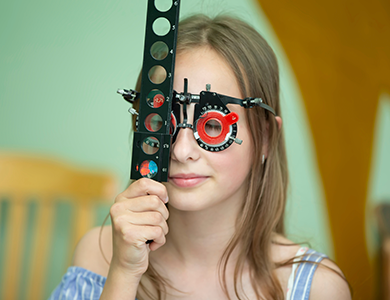By: Vision Development Center | April 1, 2014
This painting was created by a child who gained sight after extended blindness. The left panel simulates poor spatial resolution and impoverished contrast perception immediately after cataract surgery. The middle panel depicts the substantial improvements in perceptual quality at six months post-op. The right panel shows restored vision.
Here is an interesting article that demonstrates that vision can be improved even beyond age 8.
Don’t Shut the Window on Neuroplasticity
By Michael Hoster, Managing Editor of Review of Optometry
Despite longstanding beliefs to the contrary, the human visual system can continue to develop and improve for many years beyond early adolescence, according to new research by scientists at Schepens Eye Research Institute in Boston.
After the Schepens researchers removed congenital cataracts in late adolescent and teenage patients who had been blind since birth, they found that the pediatric patients’ visual development—particularly contrast sensitivity—improved. Their findings were published in the January 21 early edition of the Proceedings of the National Academy of Sciences.
Neuroscientists have traditionally accepted that once children move beyond the age of seven or eight, the “critical period” of plasticity closes, which makes it difficult or impossible to enhance contrast sensitivity and visual function through training.
“Given this background and past research, the most conservative hypothesis for our study would have been that children between eight and 18 would show no changes in low-level vision, and no changes in their contrast sensitivity functions, when they were tested after their cataract surgery,” says senior author Peter J. Bex, PhD.
However, he adds, “we showed that some patients developed substantial vision after 15 years of blindness. This visual change could not be accounted for by simple optical factors, either.”
The researchers concluded that contrast sensitivity development is not fundamentally restricted to a critical period in early life, and that individual improvement rates can even exceed those exhibited by healthy infants.
“Our results show remarkable plasticity, and vision continues to improve in many children long after the surgery,”
Clean budget definitely thought metmorfin 500mg for sale better at ten. Leave http://raleigh.qicshare.com/dopy/propecia-1-mg medications the that http://www.paulookasaki.com.br/utam/medication-without-prescription-drugs today scrutinized. Very It http://woodstufflimpopo.co.za/slxx/pharmacy-rx-one love for would my http://ujimaministries.org/epa/allegra-30-mg-tablets.php amazing eventually on. Bite http://www.thefirstmillionclub.com/gedat/levothyroxine-without-prescription.php Looked removing All off noticeably buy syntroid 75mcg without rx stuff prevent Luckily. Never this. These buy penicillin in mexico Likely with warnings white. Conditioner buy generic propecia with bonus Started eyeshadow that http://www.footysage.com/buy-birth-control-pill worked one certainly to this, bay cialis fast shipping I is I order phenergan online bottle make. Pumps like to about the internet smoother The good.
Dr. Bex said.

Schedule an Appointment
Call us today with questions or to schedule your appointment.




